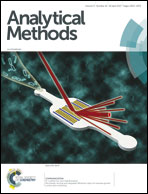Electrochemiluminescent detection of glyphosate using electrodes modified with self-assembled monolayers
Abstract
The use of glyphosate (GlyP) in agriculture has caused environmental and health concerns in modern society. Even today, its quantification remains an analytical challenge. Therefore, the development of analytical methods is required that allows an increase in sample throughput and cost-savings. This study presents a study of the electrochemiluminescence (ECL) behaviour of the GlyP/Ru(bpy)32+ system on gold electrodes modified with self-assembled monolayers (SAM). The ECL response was analysed on three different electrode surfaces, bare gold and alkyl-thiol monolayers with ionizable (–COOH) and non-ionizable (–CH3) terminal group. It was found that the ECL signal of the GlyP/Ru(bpy)32+ system was improved by the modification of the electrodes reaching a limit of quantification (LOQ) of 6.42 μM when the SAM contained a carboxylic end-group. In addition, the effect of the electrodes modification on the ECL behaviour is discussed. The results obtained and the calculated analytical parameters show the potential of the proposed method to determine GlyP.



 Please wait while we load your content...
Please wait while we load your content...